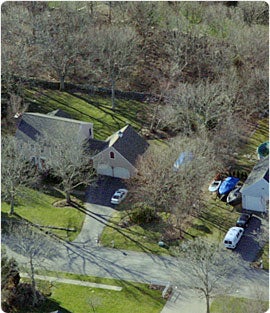Warm winter weather, the 2010 acorn crop, chipmunks and mice, the absence of acorns in 2011: these are environmental factors that have been all over the news, and are topics being discussed by tick and health experts as setting us up for what could be the worst year for deer ticks and Lyme disease on record.
TickEncounter [TERC] recently sat down with two of Rhode Island’s newest TickSmart™Certified deer tick control experts Greg Carbone of the Bartlett Tree Experts and Ames Kaiser of Ocean State Tick Control – to discuss their thoughts on tick-bite prevention for this tick season.
[Greg] We like to have a pretty good sense about whether the client has a tick problem before signing them up. Some people have heard a lot about Lyme disease but just may not have suitable tick habitat on their property. We try and educate them about the types of habitats that support tick populations. Sometimes, we’ll even do tick flagging to monitor for ticks. But if the landscape conditions suggest that there could be deer ticks, then we recommend a two or three treatment high-pressure spray program targeting the tick habitat-not the whole yard. The high-pressure is important for turning the leaf-litter over so that the spray directly contacts the ticks.

[Ames] That’s very similar to our approach. Some of our tree and landscape clients ask us about ticks and whether they should be doing something, or sometimes we bring it up to the client, especially if one of our own crew finds ticks while working on the property. Our basic program targets nymphal stage deer ticks – nymphs appear around the third week in May, and we like to have our first treatment out by Memorial Day because we know that’s a time when people will be out in their yards. Nymph populations usually reach peak abundance around the second week in June, so we try and get our second treatment out about that time. I agree that spraying the perimeter of the yard and any other brushy garden features within the yard seems to provide the best protection with the least amount of spraying.[Greg] Our third spray targets adult stage deer ticks, which don’t become active until October. We prefer scheduling that third treatment beginning at the end of the first week in October, which may seem odd since most people think pests like mosquitoes and ticks die off after a frost. But these adult deer ticks are different – that’s the time they start biting, and they’ll remain active past Thanksgiving or even longer depending on snow cover and ground freezing.
[TERC] What feedback do you hear from your tick control customers?
[Ames] More of our clients often don’t see the nymphs. Those ticks are so small! But they want tick control anyway because either someone in the family or a neighbor has had Lyme. They DO see adult stage ticks – adult deer ticks in the Fall, and newly emerging adult stage American dog ticks and left-over adult deer ticks in the early spring. So, many of our clients ask for four treatments. Even though dog ticks don’t transmit Lyme, they’re looking for piece-of-mind when it comes to tick bite protection.[Greg] We frequently hear that the ticks weren’t bad in the summer but were out in the Fall. I think that a lot of people aren’t that familiar with tick lifecycles. The nymph stage is active from late May through July but they are small – just the size of poppy seeds – so even if there are plenty around, even biting people and pets, they can go unnoticed. Most cases of Lyme happen in the summer, and that’s why people get Lyme; they never even see the nymph tick that bit them. When they understand that, they better appreciate why we are spraying in May and June. But like you Ames, we don’t want our clients to find adult ticks either, so targeting treatment on the adults is more for client retention than for disease prevention. We do hear that they see A LOT fewer ticks after having the treatment than they used to before having the treatment.[Ames] I agree. I would say that most of our clients feel that the tick treatment is a terrific value – over the potential alternative of getting sick or worse, from a tick bite.
[TERC] Are there any special program options that you offer?
[Greg] In addition to the perimeter sprays we also recommend using Damminix Tick Tubes. That product targets mice, which are everywhere, and are the main host involved in infecting the ticks with Lyme. It’s made with permethrin-treated cotton nest material that the mice steal and put in their nests. Studies have shown that if applied correctly, it can reduce tick infection rates, which is a great way to reduce the probability of being bitten by an infected tick. Not everyone wants to add that to their program but it can be a great compliment to spraying, and some people prefer using less chemical on their properties.[Ames] We like to recommend that our clients integrate tick habitat reduction with our tick spray program. As arborists, we can offer opening up the tree canopy to let in more light and lower the humidity. Deer tick nymphs are really prone to drying out. And our early Spring spray – starting in mid-March – targets the emerging adult dog ticks and re-emerging adult deer ticks just as the crocuses are popping out of the ground.[Greg] We’re also going to be very interested in TERC’s up-coming evaluation of minimal risk natural tick control products. Some of our customers are interested in products that they feel may be safer than the synthetic pyrethroids.
[TERC] How valuable is your TickSmart™ Certification to you or your customers?
[Ames] Our company feels that it’s important to give the client the best possible service and products for the job. Since deer ticks are very different than American dog ticks – different seasonal distribution, different preferred habitats and host-seeking habits, a much greater public health risk – it’s real important to work with tick experts at URI so that we know everything that we can about our target pest. Having taken the class helps me feel confident that our tick crew has a program that works, and we can answer just about any question that our clients may have. The TickSmart™ training class was far more intensive than any of our other certification training.[Greg] The TickSmart™ training started by explaining the science behind deer tick control. That’s important to my company, knowing that our program is based firmly on deer tick biology and that our strategy is effective and eco-friendly. We also value providing our employees with the best safety program possible, and the class showed us what we should be doing to stay safe as well.[Ames] Our clients count on us to stay current on best practices.[Greg] I had new cards printed so that my clients and potential clients know that I’m TickSmart™ certified in deer tick control. It definitely gives my clients confidence that our program offers the best protection in the industry for their family.


